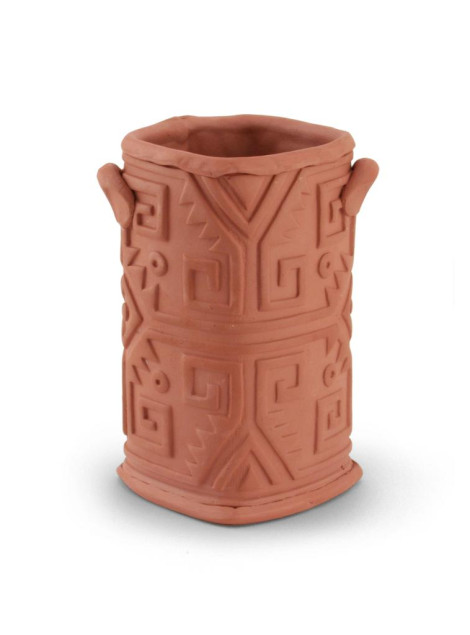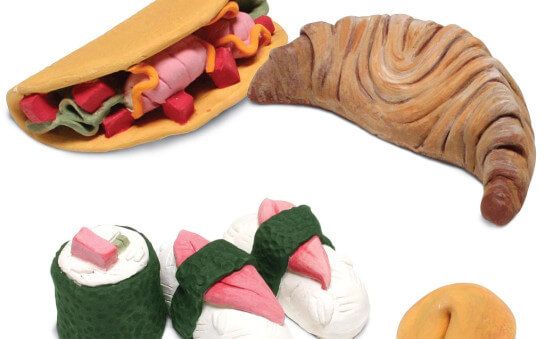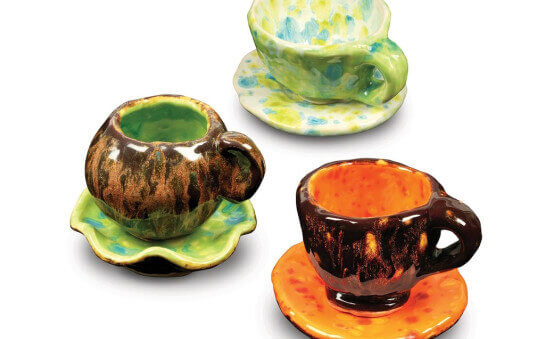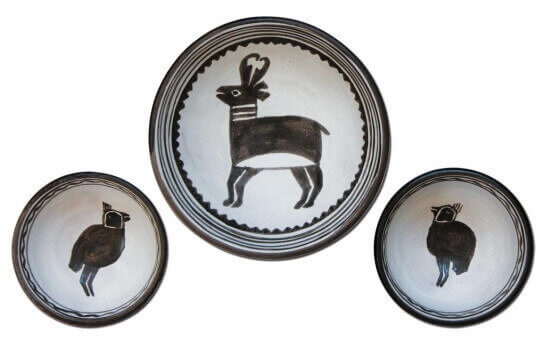Textured Pottery

Throughout history, artists from around the world have created symbols and images that reflect their culture. Many of their ideas were inspired by their environment and beliefs. Their artwork is a visual record of their time and culture. Because of this record we have a better understanding of how they lived. We know that the Koi fish is often represented in the artwork from Asia. Aboriginal artists painted simple shapes and dots on their work as well as aquatic and human forms. Islamic artists created very ornate patterns that were inspired by nature. Those patterns can still be seen today in the buildings that have survived time. Pre-Columbian artists incorporated ornate geometric patterns in their work. They also carved ferocious animals and mythological creatures onto the walls of stone temples. The AMACO® multicultural textures can be used to reinforce your classrooms study of cultures from around the world.
- Sedona Red Clay 67 Moist
- Textured Slab Molds
- Hardwood Rolling Pin
- Hardwood Thickness Strips
- Potter's Needle Tool
- Self-Hardening Mexican Pottery Clay
- Scoring Tool
- Wire Clay Cutter
- Brushes
- Sponges

Background and Preparation
Introduce the project with visual images representing patterns from one or more of the cultures listed above. The patterns can be found on many different types of artwork from the cultures. Examples could include: pottery, clothing or textiles, and jewelry. Discuss with the students what inspired the different elements in the patterns. Many of the images or symbols represented in the patterns come from nature. Native plants and animals have been an inspiration for artists throughout history. Many of the patterns have geometric as well as organic shapes. Discuss with the students the difference between the two types of shapes. Older students could be encouraged to research the different cultures and find examples of symbols or designs that were unique to that culture.
Make Slabs
Roll out 3/8" thick slabs of air-dry clay by using a slab roller or rolling pin and slats of wood. Remember to rotate the slab a quarter turn between each pass with the rolling pin (this will ensure that the slab is evenly rolled in both directions).
Template
Using a template, cut a rectangular shape from the slab. Short form = 3" x 11", medium form = 5" x 11", and tall form = 6" x 11". Save enough of the remaining clay slab to create the bottom.
Texture
Smooth out any unwanted canvas texture with a metal or flexible clay rib. Select area of texture mold that you want to use and place clay over that area.
Sandbag
Firmly tamp clay onto mold using a sandbag. This will help to impress all of the texture and keep the clay from moving when rolled with the pony roller.
Roll
Use the pony roller to firmly roll the clay onto the texture mold.
Remove From Mold
Carefully lift the clay off the textured slab mold.
Prepare Tube
Wrap a piece of paper around cardboard tube and secure with tape. Tip: Do not tape the paper to the tube because it will prevent the tube from being easily removed.
Roll Slab onto Tube
Turn the slab texture-side down and line up the bottom edge of the tube with the bottom edge of the clay.
Stand Up Cylinder
Lift edge of clay and roll clay around the tube and stand cylinder up.
Score
Use the clay scoring tool to rough up the clay to insure that it will stick together. First score the textured side of one end of the slab then score the opposite end on the smooth side of the slab. This will create an overlap of the seam.
Slip or Vinegar
Use slip or water when joining the two ends to insure that the seam will stay together. Gently overlap the two ends to create the overlapping seam.
Join
Gently overlap the two ends to create the overlapping seam. Press the seam together taking care not to distort your pressed texture.
Remove Tube
Slip the cardboard tube out of clay cylinder and remove the paper as well.
Shape: Oval
The clay cylinder can be left round or it can easily be formed into an oval by placing your hands on opposite sides of the cylinder and gently pressing in on the sides. Rotate the cylinder 180 degrees and repeat the process to even out the oval shape.
Shape: Square
The square shape begins like the oval form. Once you have the oval shape press out from the inside with dowel or paintbrush handle in the center of the large curve to create additional corners.
Trace Shape onto Slab for Base
Place cylinder on remaining clay slab and lightly trace around cylinder to mark where you will need to score the clay. Use the scoring tool to score inside the mark that you just made.
Attach Base
Score the bottom of the cylinder and use slip or water to join the two pieces together.
Trim Foot
Place cylinder on remaining clay slab and lightly trace around cylinder to mark where you will need to score the clay. Use the scoring tool to score inside the mark that you just made. Score the bottom of the cylinder and use slip or water to join the two pieces together.
Finish Foot
Back cutting at a 45 degree angle will create a shadow under the cylinder and it can also give it a more finished look.
Smooth Rim and Foot
A slightly moist sponge can be used to smooth out the top and bottom edges of your piece.
Optional: Handles
Simple lug handles are created by rolling out two small coils (about 3/4" long) and placing a slight bend in the middle to create a “U” shape. Attach handles to the side of cylinder remembering to score and use slip or water to bond the clay together.
Attach Handles
Use your thumb and fingers to firmly press the lug handles onto the cylinder. This will also leave an impression in the handle.
Firing and Glazing
Allow the clay to dry until it is no longer cool to the touch. The air dry clay can then be painted with a variety of different paints. Try painting clay with a base coat of black acrylic paint then use Rub & Buffs to highlight the textures. If using a ceramic firing clay such as AMACO® No. 67 Sedona Red Clay, allow to dry, then bisque fire to Cone 04. Glaze if desired and fire to recommended temperature on glaze jar label.




